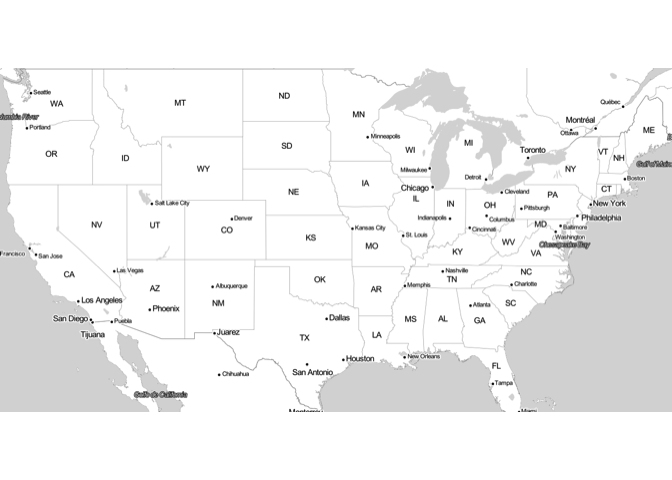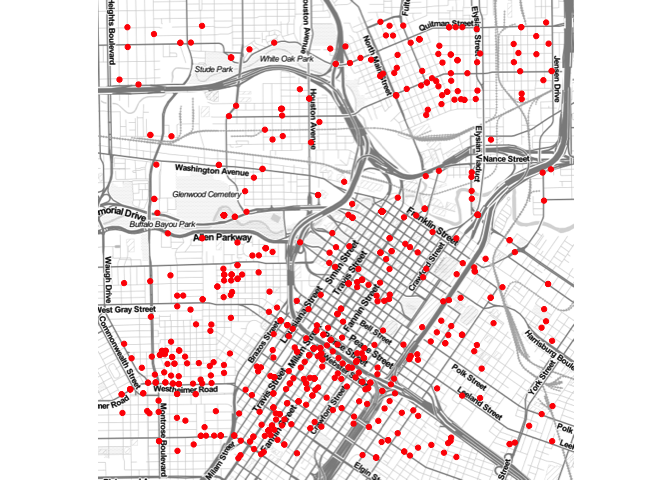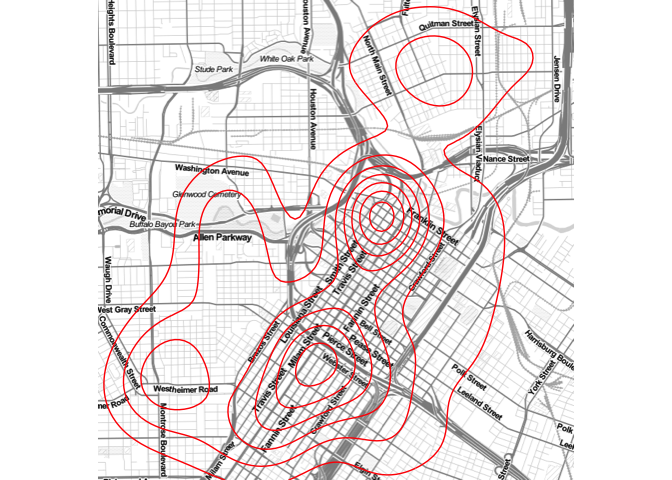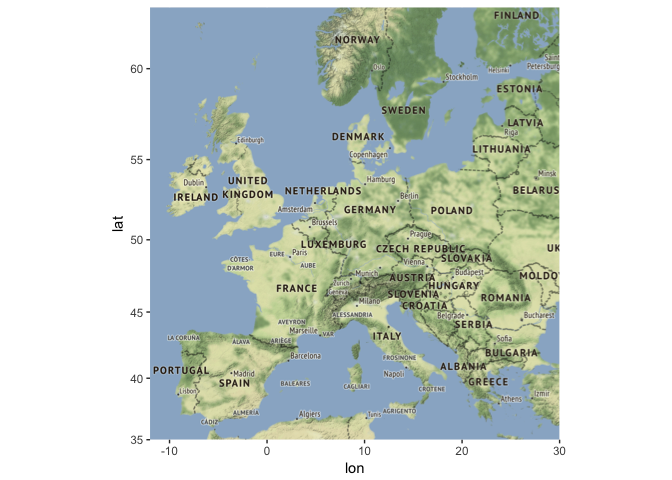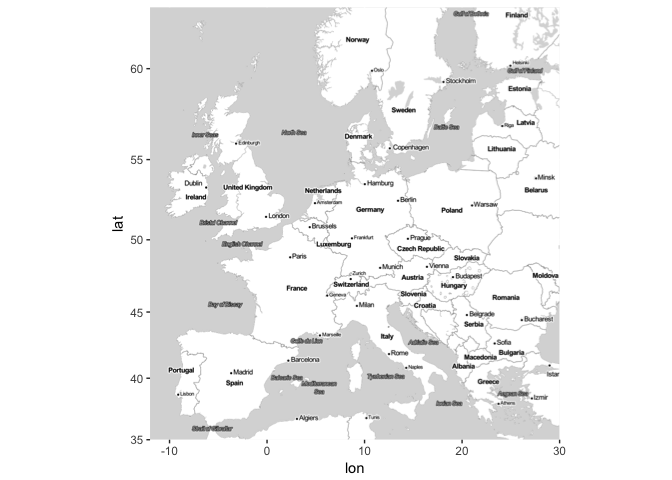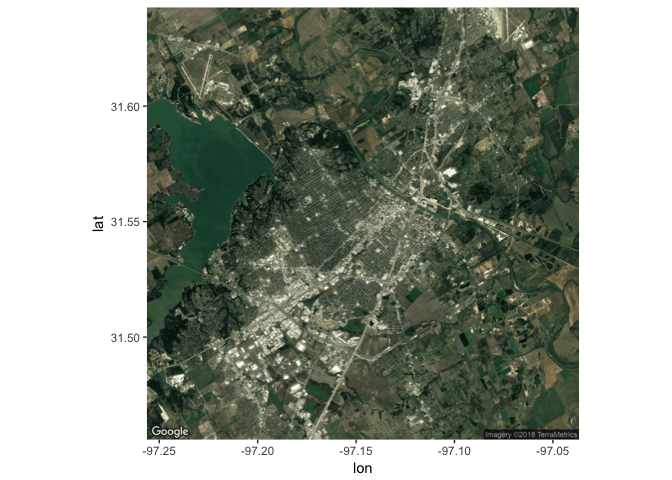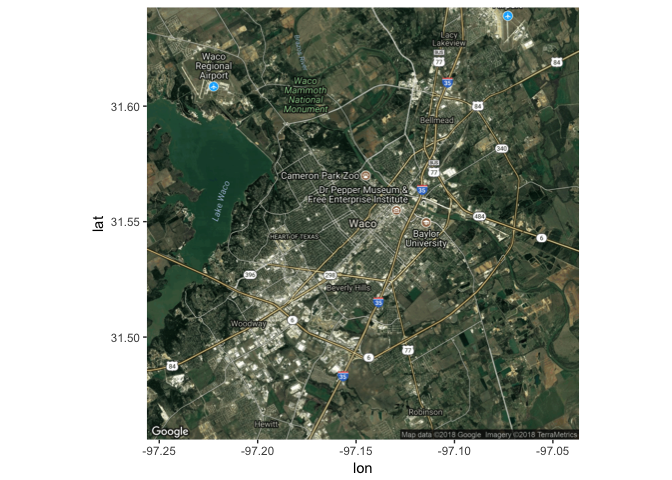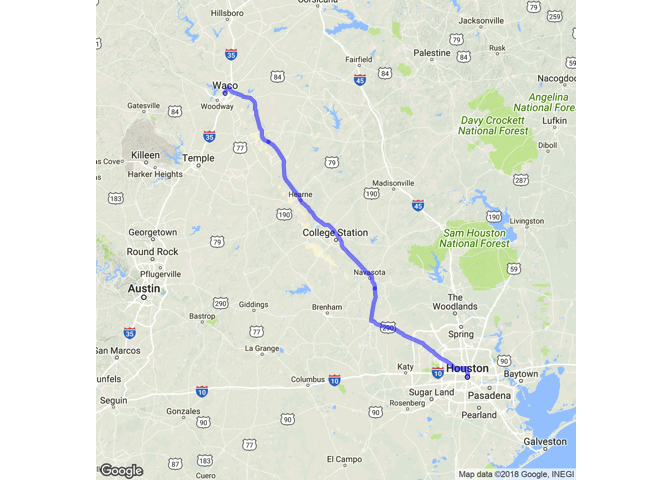ggmap makes it easy to retrieve raster map tiles from popular online mapping services like Google Maps, OpenStreetMap, Stamen Maps, and plot them using the ggplot2 framework:
library("ggmap")
us <- c(left = -125, bottom = 25.75, right = -67, top = 49)
map <- get_stamenmap(us, zoom = 5, maptype = "toner-lite")
ggmap(map)ggmap(map, extent = "device")Use qmplot() in the same way you’d use qplot(), but with a map
automatically added in the background:
library("dplyr")
library("forcats")
# define helper
`%notin%` <- function(lhs, rhs) !(lhs %in% rhs)
# reduce crime to violent crimes in downtown houston
violent_crimes <- crime %>%
filter(
offense %notin% c("auto theft", "theft", "burglary"),
-95.39681 <= lon & lon <= -95.34188,
29.73631 <= lat & lat <= 29.78400
) %>%
mutate(
offense = fct_drop(offense),
offense = fct_relevel(offense,
c("robbery", "aggravated assault", "rape", "murder")
)
)
# use qmplot to make a scatterplot on a map
qmplot(lon, lat, data = violent_crimes, maptype = "toner-lite", color = I("red"))All the ggplot2 geom’s are available. For example, you can make a
contour plot with geom = "density2d":
qmplot(lon, lat, data = violent_crimes, maptype = "toner-lite", geom = "density2d", color = I("red"))
# Using zoom = 14...In fact, since ggmap’s built on top of ggplot2, all your usual ggplot2 stuff (geoms, polishing, etc.) will work, and there are some unique graphing perks ggmap brings to the table, too.
robberies <- violent_crimes %>% filter(offense == "robbery")
qmplot(lon, lat, data = violent_crimes, geom = "blank",
zoom = 15, maptype = "toner-background", darken = .7, legend = "topleft"
) +
stat_density_2d(aes(fill = ..level..), geom = "polygon", alpha = .3, color = NA) +
scale_fill_gradient2("Robbery\nPropensity", low = "white", mid = "yellow", high = "red", midpoint = 650)Faceting works, too:
qmplot(lon, lat, data = violent_crimes, maptype = "toner-background", color = offense) +
facet_wrap(~ offense)For convenience, here are a few maps of Europe:
europe <- c(left = -12, bottom = 35, right = 30, top = 63)
get_stamenmap(europe, zoom = 5) %>% ggmap()get_stamenmap(europe, zoom = 5, maptype = "toner-lite") %>% ggmap()Google Maps can be used just as easily. However, since Google Maps use a center/zoom specification, their input is a bit different:
get_googlemap("waco texas", zoom = 12) %>% ggmap()
# Source : https://maps.googleapis.com/maps/api/staticmap?center=waco+texas&zoom=12&size=640x640&scale=2&maptype=terrain
# Source : https://maps.googleapis.com/maps/api/geocode/json?address=waco%20texasMoreover, you can get various different styles of Google Maps with ggmap (just like Stamen Maps):
get_googlemap("waco texas", zoom = 12, maptype = "satellite") %>% ggmap()
# Source : https://maps.googleapis.com/maps/api/staticmap?center=waco+texas&zoom=12&size=640x640&scale=2&maptype=satellite
# Source : https://maps.googleapis.com/maps/api/geocode/json?address=waco%20texasget_googlemap("waco texas", zoom = 12, maptype = "roadmap") %>% ggmap()
# Source : https://maps.googleapis.com/maps/api/staticmap?center=waco+texas&zoom=12&size=640x640&scale=2&maptype=roadmap
# Source : https://maps.googleapis.com/maps/api/geocode/json?address=waco%20texasget_googlemap("waco texas", zoom = 12, maptype = "hybrid") %>% ggmap()
# Source : https://maps.googleapis.com/maps/api/staticmap?center=waco+texas&zoom=12&size=640x640&scale=2&maptype=hybrid
# Source : https://maps.googleapis.com/maps/api/geocode/json?address=waco%20texasGoogle’s geocoding and reverse geocoding API’s are available through
geocode() and revgeocode(), respectively:
geocode("1301 S University Parks Dr, Waco, TX 76798")
# Source : https://maps.googleapis.com/maps/api/geocode/json?address=1301%20S%20University%20Parks%20Dr%2C%20Waco%2C%20TX%2076798
# lon lat
# 1 -97.1161 31.55099
revgeocode(c(lon = -97.1161, lat = 31.55098))
# Information from URL : https://maps.googleapis.com/maps/api/geocode/json?latlng=31.55098,-97.1161
# [1] "1301 S University Parks Dr, Waco, TX 76706, USA"There is also a mutate_geocode() that works similarly to
dplyr’s mutate() function:
df <- data.frame(
address = c("1600 Pennsylvania Avenue, Washington DC", "", "waco texas"),
stringsAsFactors = FALSE
)
df %>% mutate_geocode(address)
# Source : https://maps.googleapis.com/maps/api/geocode/json?address=1600%20Pennsylvania%20Avenue%2C%20Washington%20DC
# Source : https://maps.googleapis.com/maps/api/geocode/json?address=waco%20texas
# address lon lat
# 1 1600 Pennsylvania Avenue, Washington DC -77.03657 38.89766
# 2 NA NA
# 3 waco texas -97.14667 31.54933Treks use Google’s routing API to give you routes (route() and
trek() give slightly different results; the latter hugs roads):
trek_df <- trek("houson, texas", "waco, texas", structure = "route")
# Source : https://maps.googleapis.com/maps/api/directions/json?origin=houson%2C%20texas&destination=waco%2C%20texas&mode=driving&units=metric&alternatives=false
qmap("college station, texas", zoom = 8) +
geom_path(
aes(x = lon, y = lat), colour = "blue",
size = 1.5, alpha = .5,
data = trek_df, lineend = "round"
)
# Source : https://maps.googleapis.com/maps/api/staticmap?center=college+station,+texas&zoom=8&size=640x640&scale=2&maptype=terrain&language=en-EN
# Source : https://maps.googleapis.com/maps/api/geocode/json?address=college%20station%2C%20texas(They also provide information on how long it takes to get from point A to point B.)
Map distances, in both length and anticipated time, can be computed with
mapdist()). Moreover the function is vectorized:
mapdist(c("houston, texas", "dallas"), "waco, texas")
# Source : https://maps.googleapis.com/maps/api/distancematrix/json?origins=dallas&destinations=waco%2C%20texas&mode=driving&language=en-EN
# Source : https://maps.googleapis.com/maps/api/distancematrix/json?origins=houston%2C%20texas&destinations=waco%2C%20texas&mode=driving&language=en-EN
# from to m km miles seconds minutes
# 1 houston, texas waco, texas 299319 299.319 185.99683 10539 175.65000
# 2 dallas waco, texas 152481 152.481 94.75169 5360 89.33333
# hours
# 1 2.927500
# 2 1.488889If you have a Google API key, you can exceed the standard limits Google places on queries. By default, when ggmap is loaded it will set the following credentials and limits:
ggmap_credentials()
# Google -
# key :
# account_type : standard
# day_limit : 2500
# second_limit : 50
# client :
# signature :Look at the documentation of ?register_google() to learn more. If you
do have an API key, you set it with:
register_google(key = "[your key here]", account_type = "premium", day_limit = 100000)
ggmap_credentials()
# Google -
# key : [your key here]
# account_type : premium
# day_limit : 1e+05
# second_limit : 50
# client :
# signature :These will then be used and checked when creating the query URL:
register_google(key = "AbCdEfGhIjKlMnOpQrStUvWxYz")
get_googlemap("waco texas", urlonly = TRUE)
# [1] "https://maps.googleapis.com/maps/api/staticmap?center=waco+texas&zoom=10&size=640x640&scale=2&maptype=terrain&key=AbCdEfGhIjKlMnOpQrStUvWxYz"For anything that hasn’t been implemente (URL-wise), you can inject code
into the query usin g inject:
get_googlemap("waco texas", urlonly = TRUE, inject = "otherItem = Stuff")
# [1] "https://maps.googleapis.com/maps/api/staticmap?center=waco+texas&zoom=10&size=640x640&scale=2&maptype=terrain&key=AbCdEfGhIjKlMnOpQrStUvWxYz&otherItem%20=%20Stuff"-
From CRAN:
install.packages("ggmap") -
From Github:
devtools::install_github("dkahle/ggmap")

